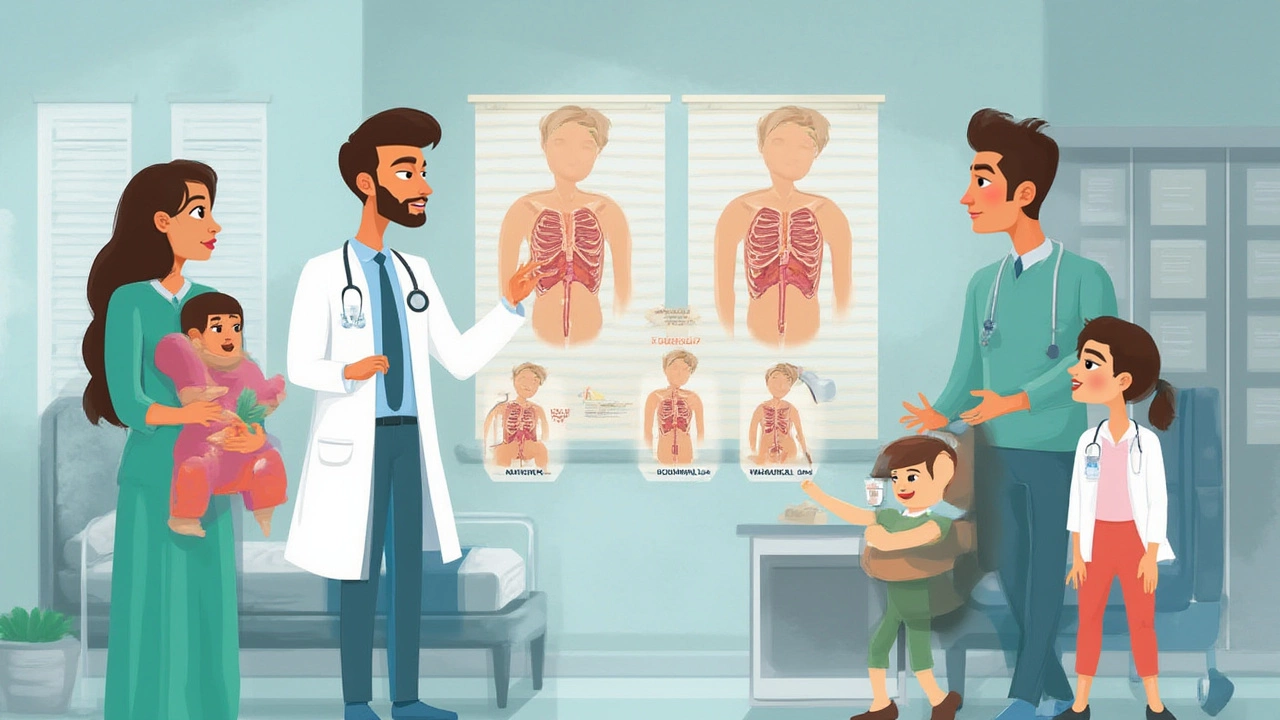You're lying on a hospital bed, bright lights above, medical chatter in the background, and this one question in your head: "Are they really going to break my ribs to get to my heart?" Every movie and TV scene about heart surgery seems to show hammers and bone saws, but what's the actual deal in Bangalore, or anywhere else today? Does open heart surgery really involve breaking ribs, or is that stuck in the past—just like floppy disks and dial-up?
How Surgeons Access the Heart: Ribs, Sternums, and Modern Techniques
The heart sits behind the breastbone, right in the middle of your chest. Surgeons call this breastbone the sternum. Most classic open heart surgeries still use a method called a median sternotomy. This means the surgeon makes a vertical cut down the center of the chest, then splits the sternum—not the ribs—with a special saw to reach the heart. The ribs are attached to the sternum, but breaking ribs isn't routinely required. They use a device to gently spread the ribcage apart, sort of like opening a hardback book. This gets them enough space to work on the heart, valves, arteries, or whatever needs fixing or replacing.
Some folks believe ribs are broken because the after-effects feel intense: chest pain, deep bruising, and difficulty moving. But while the sternum is divided, rib bones themselves almost always stay intact. According to a 2022 study from the American Association for Thoracic Surgery, the risk of rib fractures during open heart surgery is less than 1%—and it's usually accidental, not intentional.
| Surgery Type | Sternum Split? | Ribs Broken? | Healing Time |
|---|---|---|---|
| Traditional Open Heart | Yes | Rarely | 6-12 weeks |
| Minimally Invasive Heart Surgery | No | No | 2-4 weeks |
| Robotic-Assisted Surgery | No | No | 2-4 weeks |
These days, many hospitals in cities like Bangalore—especially in the bigger, world-class ones—offer minimally invasive heart surgery options. If possible, they go through a small incision on the side, between the ribs, and use scopes and delicate surgical instruments to reach the heart. Think keyhole surgery for your ticker. No need to split the sternum or break ribs at all. Healing is much easier, and you can often go home within a week. But not everyone is a candidate. It all depends on your health, your heart's problem, and the hospital's available technology.
The tools and technology have come a long way from what our parents or grandparents might remember. My own uncle had coronary artery bypass surgery twenty years ago at a hospital in Mumbai. Back then, the recovery was brutally long. Six weeks of soreness, months of physiotherapy. Today, his neighbor went back to work just three weeks after minimally invasive mitral valve repair. That's a massive leap, and it makes open heart surgery way less daunting.
It's fascinating that in some rare, urgent cases—like a traumatic chest injury or very complex heart defects—the surgeons still might have to work quickly and forcefully, and accidents like rib fractures can happen. But if you or someone you know is heading in for planned open heart surgery, the odds are high that no ribs will be intentionally broken. Most of the time it's all about careful, steady hands and precise tools.
Dr. Devi Shetty, a respected heart surgeon from Bangalore, once explained,
"In modern heart surgery, breaking ribs is extremely rare and is never the goal—our focus is reducing injury and helping the patient get back to life as quickly as possible."
If you’re the practical type, here’s something that might be useful. Always ask your surgeon these questions if you're scheduled for heart surgery:
- How will you access my heart? (Sternum, ribs, minimally invasive?)
- Are there options other than the standard method?
- What will my pain and recovery feel like?
- How soon can I get back to walking, working, or playing with my kids?
Doctors will spell out what's best for you, but you have every right to know if they're going to split your sternum, gently spread the ribs, or slide through a tiny opening.

The Reality of Recovery: Pain, Healing, and Getting Life Back
So, what about the recovery? If you've had your sternum split open, you’ll probably feel like you've been run over by an auto. The chest is sore, movements are careful, and hugging your kids—like I do with Ira—needs a bit of caution for a while.
But let’s get specific. For most open heart surgeries done via sternotomy, the sternum is closed up with strong wires, almost like twist ties for bones. Those wires stay inside forever, giving the bone stability as it heals. Most people stay in the hospital for 5-7 days, depending on how things go. At home, you’ll be told to avoid lifting heavy weights (no carrying big groceries or kids!), sleep on your back, and maybe wear a chest binder for support. If there were ribs broken accidentally, recovery could take longer or become more painful. Coughing, laughing, or even sneezing might bring sharp pain for the first couple of weeks, but painkillers and guided rehabilitation help a lot.
Of course, there are always exceptions. In folks above the age of 65, or those with conditions like osteoporosis (thinner bones), rib or even sternum fractures can happen more easily. But even then, surgeons and nurses are extra careful. They'll plan the optimal approach, trying their best to avoid extra injury.
Here's something you should note: not moving enough after surgery is a bigger danger than the chest pain itself. You have to get up, walk, and take deep breaths (yes, even if it feels tough!) to avoid lung infections and clots. Post-surgical rehab centers and online support groups—including ones in Bangalore—make a huge difference. Nurses trained in cardiac care suggest using a small pillow to hug when soon after surgery you cough or get up, to stabilize the chest and make it less painful. Trust me, it works; a close friend tried it and felt braver on day two itself.
One thing people always forget? Your driving license. In India, doctors routinely say “no driving” for six weeks after sternotomy—your reaction speed just won’t be what it was, for your sake and everyone else’s.
The psychological part matters, too. People come out of heart surgery with a cocktail of relief, hope, and sometimes fear. Even if you weren’t a gym freak before, you’ll feel sensations you never noticed—little twinges, clicks in the chest, or even buzzing from the internal wires. That’s normal. Consulting your doctor regularly and following up for blood tests, ECGs, and wound checks is part of the deal.
Anjali and I have always encouraged anyone going through any major surgery to ask for help—whether it’s calling a trusted family member, or getting a professional nurse for a week or two. No need to play the superhero. Your ribcage (and your heart) are resilient, but recovery is faster—and much less lonely—when you let people help.

Modern Heart Surgery: Myths, Facts, and the Future
We’ve all heard wild stories about what happens in an operating room, usually down the grapevine, twisted by anxiety and a little imagination. The cinema world absolutely loves a dramatic rib-cracking scene. But the facts don't match the drama. Surgeons go out of their way to minimize trauma to the chest. The technical goal is simple: reach the heart, fix what’s wrong, and close up with the smallest possible injury.
From 2015 to 2023, the number of minimally invasive heart surgeries in India went up by 200%, according to a report from the Indian Society of Cardiothoracic Surgeons. More hospitals have advanced robotic systems, and more doctors are trained for these delicate surgeries. The fewer the bones that are touched, the faster you get to grab that cup of hot chai at home (instead of hospital tea, which...well, let's not go there).
Heart surgery isn’t just a rich country affair anymore; Bangalore’s big hospitals and heart centers have made it accessible for middle-class families, too. Whether you’re in Indiranagar or Koramangala, you can find highly skilled surgeons, world-class ICUs, and the latest in patient care. Recovery support is also miles better than it was a decade ago. Many people worry about the cost, but medical insurance providers are catching up, and government programs now cover thousands of open heart surgeries every year.
| Year | Traditional (Sternotomy) | Minimally Invasive | Robotic-Assisted |
|---|---|---|---|
| 2015 | 95% | 4% | 1% |
| 2020 | 75% | 20% | 5% |
| 2024 | 60% | 30% | 10% |
A younger cousin of mine, scared of hospitals, once asked if robots would do a better job than humans. The answer? Robots are just tools; the human surgeon's steady hands and watchful eyes are still the main safety net. In the hands of an expert, even an old-school sternotomy leaves minimal trauma, and rib fractures are rare exceptions.
There are so many myths about open heart surgery that just survive because people don’t get the right answers. Are patients left with giant scars? Nope—smaller than you think, especially with new methods. Are the wires in your chest dangerous? Not at all. Do you need to give up your favorite foods forever? Not always—even my dad’s famous butter chicken is still on the family table, just with less butter. But the "breaking ribs" myth sticks around, courtesy of old horror stories and a few over-the-top TV shows.
Here’s the straight talk: heart surgeons hate causing extra injuries as much as you hate hearing about them. Open heart surgery used to mean a brutal recovery and weeks of agony. Today, it’s a planned, precise operation, and rib fractures are vanishingly rare. Ask your doctor, get clear the facts, and don’t fall for outdated myths. It’s your body, after all.
